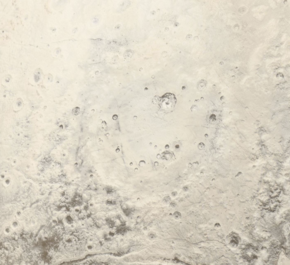Loading AI tools
Multi-ring impact basin on Pluto From Wikipedia, the free encyclopedia
Burney is the second-largest known impact basin on the dwarf planet Pluto. With a diameter of over 290 kilometres (180 miles) and possibly up to 350 kilometres (220 miles), it is the second-largest known impact basin on Pluto, after the Sputnik Planitia basin. Burney is the only impact basin with visible multiple rings known on Pluto and is thus classified as a multi-ringed impact basin,[a] though its rings have been heavily eroded due to Burney's age.
 A New Horizons of Burney basin, center. An ancient impact basin, its heavily eroded state makes it difficult to discern; its concentric rings are only slightly brighter than the surrounding plains | |
| Feature type | Multi-ring impact basin |
|---|---|
| Location | Venera Terra, Pluto |
| Coordinates | 45.68°N 133.79°E[1] |
| Diameter | 296–350 km (184–217 mi)[1][2] |
| Depth | ~1.8–3 km (1.1–1.9 mi)[2][3]: 123 |
| Discoverer | New Horizons |
| Eponym | Venetia Burney (1918–2009) |
As with the rest of Pluto's surface features, Burney was first seen on the New Horizons flyby of Pluto and its five moons on 14 July 2015. The impact basin was informally named Burney by the New Horizons team in honor of Venetia Burney, who suggested the name Pluto to the dwarf planet's discoverer Clyde Tombaugh in 1930.[5][6]: 10 The name was officially approved by the International Astronomical Union (IAU) on 8 August 2017.[1]
Burney is the second-largest impact feature known on Pluto, after the massive basin that encloses the glacial plains of Sputnik Planitia.[3]: 123 It is ancient, with an estimated age of at least 4 billion years old, and heavily eroded.[7][3]: 142 The structure of Burney resembles that of the Mare Orientale basin on the Moon, with a series of concentric peak rings that enclose a central depression. Burney's degraded state makes it difficult to discern its extent due to the subtle nature of its peak rings; Burney may have anywhere from 2–4 such rings. As such, estimates for Burney's diameter range from ~290 kilometres (180 miles) to ~350 kilometres (220 miles).[2][1] The peak rings of Burney are discontinuous and crenulated, standing roughly 500–1,000 metres (1,600–3,300 feet) high. The central depression of Burney is approximately 180 kilometres (110 miles) across and roughly 1.8–3 kilometres (1.1–1.9 miles) deep.[2][3]: 123 Within Burney are numerous smaller impact craters, one of which has been officially named Hardaway.[8]
Much of Burney's basin floor is glaciated, its surface covered in bright, coarse grains of nitrogen ice mixed with water ice.[9][10] The peak rings of Burney are additionally coated in methane ice, indicating that methane preferentially condenses on the high-altitude mountain peaks that comprise Burney's concentric rings. By contrast, Burney's floor is poor in methane ice and much smoother than the surrounding plains, possibly from differences in erosion or from heavier glaciation.[7][3]: 127–128 Several dark streaks similar to those found in Sputnik Planitia were observed in and around Burney.[11] Models of Pluto's climate indicate that Burney likely experiences downward-flowing katabatic winds.[12]
Surrounding Burney basin is a broad region to the northwest of Sputnik Planitia that hosts a type of terrain informally called washboard terrain. This terrain is characterized by parallel ridges spaced 1–2 kilometres (0.62–1.24 miles) apart and covers large parts of Burney's basin floor. One hypothesis for the origin of the washboard terrain is from the collection and deposition of material from an ancient period of heavy regional glaciation. The age of the washboard terrain appears to only marginally postdate the impact event that created Burney.[7]
Seamless Wikipedia browsing. On steroids.
Every time you click a link to Wikipedia, Wiktionary or Wikiquote in your browser's search results, it will show the modern Wikiwand interface.
Wikiwand extension is a five stars, simple, with minimum permission required to keep your browsing private, safe and transparent.